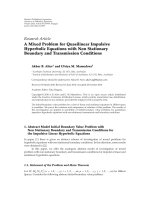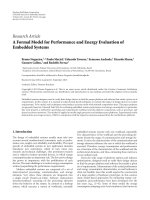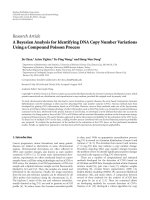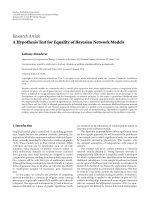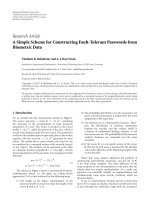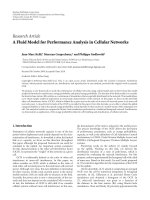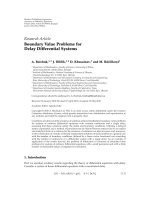Báo cáo sinh học: " Research Article A Hierarchical Estimator for Object Tracking" pot
Bạn đang xem bản rút gọn của tài liệu. Xem và tải ngay bản đầy đủ của tài liệu tại đây (2.39 MB, 11 trang )
Hindawi Publishing Corporation
EURASIP Journal on Advances in Signal Processing
Volume 2010, Article ID 592960, 11 pages
doi:10.1155/2010/592960
Research Article
A Hierarchical Estimator for Object Tracking
Chin-Wen Wu,
1
Yi-Nung Chung,
2
and Pau-Choo Chung
1
1
Department of Electrical Engineering, Institute of Computer and Communication Engineering, National Cheng Kung University,
Tainan 701, Taiwan
2
Department of Electrical Engineering, National Changhua University of Education, Changhua 500, Taiwan
Correspondence should be addressed to Yi-Nung Chung,
Received 17 November 2009; Revised 27 March 2010; Accepted 14 May 2010
Academic Editor: Hsu-Yung Cheng
Copyright © 2010 Chin-Wen Wu et al. This is an open access article distributed under the Creative Commons Attribution License,
which permits unrestricted use, distribution, and reproduction in any medium, provided the original work is properly cited.
A closed-loop local-global integrated hierarchical estimator (CLGIHE) approach for object tracking using multiple cameras is
proposed. The Kalman filter is used in both the local and global estimates. In contrast to existing approaches where the local
and global estimations are performed independently, the proposed approach combines local and global estimates into one for
mutual compensation. Consequently, the Kalman-filter-based data fusion optimally adjusts the fusion gain based on environment
conditions derived from each local estimator. The global estimation outputs are included in the local estimation process. Closed-
loop mutual compensation between the local and global estimations is thus achieved to obtain higher tracking accuracy. A set of
image sequences from multiple views are applied to evaluate performance. Computer simulation and experimental results indicate
that the proposed approach successfully tracks objects.
1. Introduction
Visual object tracking is an important issue in computer
vision. It has applications in many fields, including visual
surveillance, human behavior analysis, maneuvering target
tracking, and traffic monitoring. The two main types of
visual tracking algorithms are target representation and
localization algorithms and filtering and data association
algorithms [1]. For target representation and localization
algorithms, tracking a moving object typically involves
matching objects in consecutive frames using features such as
edge, region, shape, texture, position, and color. Comaniciu
et al. [1] presented a kernel-based framework for tracking
nonrigid objects. The mean shift algorithm [2] uses the
repeated movement of data points to the sample means. The
mean shift algorithm is shown to have effective computation
and good tracking performance, but it tends to converge to
a local maximum. For filtering and data association algo-
rithms, the state estimation method is used for modeling the
dynamic system of visual tracking. The state space approach
recursively estimates the state vector in two consecutive
stages: prediction and updating. In the prediction step, the
prior estimate of the current state is derived using a dynamic
equation. In the updating step, the posterior estimate of
the state is updated based on measurements. A state space
approach which incorporates measurements into existing
object tracks within the framework of Kalman filtering was
developed in [3]. Cui et al. [4] presented a laser-based dense
crowd tracking method. Particle filters, which are based on
the Monte Carlo integration method for implementing a
recursive Bayesian filter, have also been proposed [5, 6].
The key idea is to represent the required posterior estimate
by a set of random samples with associated weights. A
particle filter can effectively deal with clutter and ambiguous
situations. However, if the dimension of the state vector is
high, a particle filter has a very large computational cost [7–
9]. Cheng and Hwang [10] combined a Kalman filter with
particle sampling for multiple-object video tracking.
In the tracking procedure, once measurements are
received, data association must be applied to determine
the exact relationship between measurements and predicted
objects. Several algorithms have been developed for data
association, such as probabilistic data association (PDA) and
joint probabilistic data association (JPDA) [11]. The PDA
approach for multitarget tracking, presented by Kershaw and
Evans [12], reduces the complexity associated with more
sophisticated algorithms by focusing on a few most likely
hypotheses.
2 EURASIP Journal on Advances in Signal Processing
Local estimator Global estimator
Camera pair 1
from two-view
Kalman
filter based data
fusion
Kalman filter
Camera pair N
from two-view
Kalman filter
x
+
N
(k)
x
+
1
(k)
X
+
(k)
State estimate
X
+
(k),
P
+
(k)
.
.
.
.
.
.
.
.
.
Figure 1: Proposed Kalman-filter-based hierarchical estimator for object tracking.
Gate
O6
Gate
O3
P2
O2
O1
P3
O4
P1
O5
O7
Gate
O1 ∼ O7
= Observation positions
P1, P2, P3
= Predicted target positions
Figure 2: Relationship between predicted objects and measure-
ments based on the gating technique.
Occlusion is considered an essential challenge in tracking
moving objects. Consequently, a number of recent studies
have used multiple views to handle occlusion [13–19]. In
[13], a recursive algorithm for stereo was developed. The
scheme uses an extended Kalman filter to recursively estimate
3D motion and the depth of moving objects. In [14], a
discrete relaxation approach for reducing the intrinsic com-
binatorial complexity was introduced. The algorithm uses
prior knowledge from 2D tracking of each view to obtain
real-time 3D tracking. Hu et al. [15] proposed a framework
for tracking multiple people about uncalibrated occlusion
reasoning. Khan and Shah [16] presented a tracking system
based on the field of views (FOVs) of multiple cameras.
Another 3D object tracking method that uses multiple
views was presented in [17]. Ercan et al. [18] proposed
0
2
4
6
8
10
12
Position error
0 20 40 60 80 100 120 140 160 180 200
Tracking step
(a)
0
0.2
0.4
0.6
0.8
Ve l o c i t y e r r o r
0 20 40 60 80 100 120 140 160 180 200
Tracking step
Proposed
Austere fusion
(b)
Figure 3: Comparison of the position and velocity errors between
proposed method and Austere fusion method.
a particle-based framework for single-object tracking with
occlusions in a camera network. This approach requires
prior knowledge of the environment and the FOV of each
camera for estimating the likelihood of whether the object
will be occluded from the view of a camera. Furthermore,
they did not address the issue of data fusion. Multiple-view
data fusion systems have been investigated in several studies
[20, 21].
Several studies on hierarchical data fusion [22–26]have
also been conducted. Majji et al. [22] presented an algorithm
EURASIP Journal on Advances in Signal Processing 3
0
5
10
15
20
Position error
0 20 40 60 80 100 120 140 160 180 200
Tracking step
Global MSE
Local-1 MSE
(a)
0
5
10
15
20
Position error
0 20 40 60 80 100 120 140 160 180 200
Tracking step
Global MSE
Local-2 MSE
(b)
0
5
10
15
20
Position error
0 20 40 60 80 100 120 140 160 180 200
Tracking step
Global MSE
Local-3 MSE
(c)
Figure 4: Comparison of global and local 3D estimation errors.
using centralized hierarchical fusion. However, the system
does not provide feedback to the local filters for modifying
their estimate. As such, their approach cannot achieve truly
local-global integration to obtain highly accurate estimate.
Ajgl et al. [23] discussed various fusion approaches and
showed that hierarchical fusion with Millman’s formula
has the best performance. Wang et al. [24] developed a
two-stage hierarchical framework with partial feedback and
applied it to compressed video. Local estimators consist of
motion, color, and face detectors. However, the measure-
mentsofsomelocalestimatesinthisschemearenotalways
available due to intracoded frame prediction. Strobel et al.
[25] presented a joint audio-video object tracking method
based on decentralized Kalman filters. The front end local
estimation uses two Kalman filters, one to track objects based
on video and the other to track objects based on audio.
The results are then passed through two inverse Kalman
filters to obtain measurements, which are applied to another
Kalman filter for global fusion to obtain the final tracking
result. Due to the use of both Kalman filtering and inverse
Kalman filtering, the method is relatively time consuming.
Furthermore, it is designed as an open-loop mechanism
and thus mutual compensation between the global and local
estimates cannot be achieved. Medeiros et al. [26] proposed
a cluster-based Kalman filter algorithm for a wireless camera
200
300
400
X
0 20 40 60 80 100 120 140 160 180 200
Tracking step
x-real
x-estimate
(a)
−350
−300
−250
Y
0 20 40 60 80 100 120 140 160 180 200
Tracking step
y-real
y-estimate
(b)
40
60
80
100
Z
0 20 40 60 80 100 120 140 160 180 200
Tracking step
z-real
z-estimate
(c)
Figure 5: Simulation results of tracking.
(sensor) network for object tracking. In their approach,
sensors that detect the same object are grouped into a cluster
and the information sensed from each individual sensor in
the cluster is sent to the cluster head for aggregation by a
Kalman filter. The Kalman filter is divided into blocks to
improve the computation efficiency. An innovative protocol
procedure between individual sensors and the cluster head
was developed. However, how to improve the tracking effi-
ciency through a local-global hierarchical fusion mechanism
was not discussed.
In contrast to existing approaches, the present study
proposes a closed-loop local-global integrated hierarchical
estimator (CLGIHE) for object tracking using multiple
cameras. The Kalman filter is used to combine the local and
global estimates into one estimate for mutual compensation
since it can be efficiently integrated into a hierarchical
fusion algorithm. The local estimate is input into the
global fusion and the obtained global estimate is fed back
to the local estimator to achieve iterative optimization-
based improvement in both local and global estimates.
The local and global estimates are combined into one
estimate using the derived equations. The global estimate
includes the covariance (environment conditions) from all
the local estimators in the derived global fusion equations
in the adjustment of fusion gain for dynamically adjusting
4 EURASIP Journal on Advances in Signal Processing
Camera 1
Camera 3
Camera 2
Figure 6: Configuration of the tracking system in the experiment.
the tracking in the optimal estimate. Mutual compensation
between the local and global estimates is thus achieved to
obtain more accurate position estimation.
The rest of this paper is organized as follows. Section 2
provides a brief overview of the proposed system. The
proposed object tracking with hierarchical estimation is
described in Section 3. The simulation and experimental
results of the proposed approach are described in Section 4.
Finally, the conclusions are given in Section 5.
2. System Overview
The proposed hierarchical tracking system (CLGIHE) con-
sists of Local Estimator and Global Estimator, as shown
in Figure 1. Local Estimator uses data association and the
Kalman filter for estimating the 3D position of the object
using a camera pair. It should be noted that in the system,
every two cameras are considered to be a camera pair.
Given 2D images and the camera matrices, the positions
of 3D points are computed using the triangulation method
presented in [27].
Global Estimator performs data fusion of the estimates
obtained by Local Estimator to obtain more accurate 3D
global estimates. Object tracking is achieved primarily
using measurements received from local estimates that
are integrated using a data fusion algorithm to form the
global estimate. The fusion algorithm concludes the result
considering that different local estimators have different
reliability to achieve the best estimation result. Therefore,
it can provide increased robustness and accurate estimates.
After the global estimate is produced, the estimated 3D
position of the tracking object is fed back to local filters for
modifying the estimated states.
Suppose that there are N camera pairs and a total
of L objects in the system. In the system, the local and
global estimates are modeled in world coordinates, whereas
3D measurements are reconstructed by each camera pair.
The motion segmentation approach is used in each image
plane, for example, background subtraction is used to
detect a moving object to obtain a measurement for the
local estimate. After the measurement has been recon-
structed and assigned to the local estimator, the state
estimate is performed for the local filter with the measure-
ment.
The following nomenclature is used throughout this
study: x
i
denotes local estimate, “” denotes estimate, “super
T”denotetranspose,“
−” denotes the a priori estimate,
“+” denotes the a posteriori estimate, p
i
denotes the local
covariance matrix, k
i
denotes the Kalman gain of the local
estimate, X, P,andK denote the global estimate, the
covariance matrix, and the Kalman gain, respectively, I
n
denotes an n×n identity matrix, and n denotes the dimension
of state vector x
i
.
3. Proposed Hierarchical Estimator for
Object Tracking
The algorithm for CLGIHE is described in this section.
The basic idea of the proposed fusion algorithm with a
hierarchical estimation approach is to combine local and
global estimates for object tracking. The local predictor pro-
duces a 3D position estimate based on the local information
perceived by a camera pair. The local estimate results are then
sent to the global estimator to generate a global estimate of
the object.
EURASIP Journal on Advances in Signal Processing 5
0
−200
−400
−600 −400
−200
0
200
400
0
50
100
x
y
z
(a) proposed result
0
−200
−400
−600 −400
−200
0
200
400
0
50
100
x
y
z
(b) KIM fusion
0
−200
−400
−600 −400
−200
0
200
400
0
50
100
x
y
z
(c) Austere fusion
0
−200
−400
−600 −400
−200
0
200
400
0
50
100
x
y
z
(d) Local #1 result
0
−200
−400
−600 −400
−200
0
200
400
0
50
100
x
y
z
(e) Local #2 result
0
−200
−400
−600 −400
−200
0
200
400
0
50
100
x
y
z
(f) Local #3 result
0
−200
−400
−600 −400
−200
0
200
400
60
80
100
x
y
z
(g) ground truth
Figure 7: 3D tracking results for sequence 1. (a) Global estimate, (b) Kim’s fusion, (c) Austere’s fusion, (d)–(f) local estimates. (g) Ground
truth.
3.1. Local Estimate. The local estimate is computed by the
Kalman filters from measurements obtained by a camera
pair. Let x
i
be the estimated state vector in the ith Kalman
filter at step k given by:
x
i
(
k
)
=
x
i
(
k
)
˙
x
i
(
k
)
y
i
(
k
)
˙
y
i
(
k
)
z
i
(
k
)
˙
z
i
(
k
)
T
,(1)
where [x
i
(k) y
i
(k) z
i
(k)] and [
˙
x
i
(k)
˙
y
i
(k)
˙
z
i
(k)] rep-
resent the position and velocity of the tracked object, respec-
tively. The Kalman-filter-based local estimate is modeled as
x
i
(
k +1
)
= f
i
(
k
)
x
i
(
k
)
+ g
i
(
k
)
w
i
(
k
)
,(2)
where x
i
(k+1) andx
i
(k) are the state vectors at time k+1and
k, respectively, which is the number of camera pairs since one
Kalman filter is used for each local estimate from two camera
views, and f
i
(k)andg
i
(k) are the state transition and noise
coupling matrices, respectively. The system noise, w
i
(k),
associated with the moving object at frame k is assumed
to be white Gaussian noise distributed with zero mean and
covariance matrix q
i
(k).
Themeasurementequationcanbeexpressedas
y
i
(
k
)
= h
i
(
k
)
x
i
(
k
)
+ v
i
(
k
)
,(3)
where the measurement y
i
(k) is formed by a pair of image
positions of the ith local estimator at time k, h
i
(k)is
the observation matrix of the filter i,andv
i
(k) is the
measurement error, which is assumed to be white Gaussian
noise with zero mean and covariance matrix r
i
(k).
According to the dynamic system defined in (2)and(3),
the solution of the Kalman filter for this model for each
camera pair i is given by the state prediction in [3].
The updating step is expressed as
x
+
i
(
k
)
= x
−
i
(
k
)
+ k
i
(
k
)
y
i
(
k
)
− h
i
(
k
)
x
−
i
(
k
)
(4)
with error covariance
p
+
i
(
k
)
=
[
I
n
− k
i
(
k
)
h
i
(
k
)
]
p
−
i
(
k
)
,(5)
6 EURASIP Journal on Advances in Signal Processing
200
0
−200
−400
−600 −100
0
100
200
300
0
100
200
x
y
z
(a) proposed result
200
0
−200
−400
−600 −100
0
100
200
300
0
100
200
x
y
z
(b) KIM fusion
200
0
−200
−400
−600 −100
0
100
200
300
0
100
200
x
y
z
(c) Austere fusion
200
0
−200
−400
−600 −100
0
100
200
300
0
100
200
x
y
z
(d) Local #1 result
200
0
−200
−400
−600 −100
0
100
200
300
0
100
200
x
y
z
(e) Local #2 result
200
0
−200
−400
−600 −100
0
100
200
300
0
100
200
x
y
z
(f) Local #3 result
200
0
−200
−400
−600 −100
0
100
200
300
0
100
200
x
y
z
(g) ground truth
Figure 8: 3D tracking results for sequence 2. (a) Global estimate (b) Kim’s fusion (c) Austere’s fusion (d)–(f) local estimates (g) Ground
truth.
where x
−
i
(k) = f
i
(k)x
+
i
(k − 1) and
p
−
i
(
k
)
= f
i
(
k
)
p
+
i
(
k
− 1
)
f
T
i
(
k
)
+ g
i
(
k
)
q
i
(
k
)
g
T
i
(
k
)
. (6)
This process is repeated iteratively at each time instant in
all the local tracking processes. The iteration generates one
instant-time estimate and the system iteratively updates the
estimate.
3.2. Data Association. In a state estimation algorithm, one
important procedure is data association, which can be used
to determine the relationship between measurements and
existing objects. Data association usually consists of two
procedural steps: gating and correlation computation logic.
If more than one measurement exists, the data association
technique can be used to reduce the number of measure-
ments. Figure 2 shows a typical gate diagram, which consists
of three objects, P1, P2, and P3. In this figure, there are
three objects and seven observations. The gating technique is
applied to eliminate the least probable observations, such as
O
6
and O
7
.Then,O
1
, O
2
, O
3
, O
4
,andO
5
measurements,
whose association with the objects has to be determined,
remain. A suboptimal Bayesian approach, denoted as 1-
step conditional maximum likelihood, is applied to deter-
mine the association between the remaining measurements
and the objects. For the above equations, let s
i
(k) =
h
i
(k)p
−
i
(k)h
T
i
(k)+r
i
(k) be the residual covariance matrix,
and
y
i
(k) = y
i
(k) − h
i
(k)x
−
i
(k) the measurement residual
vector at time k. In each local estimator, 1-step conditional
maximum likelihood is used to obtain the state estimate
x
+
i
(k) from all the valid measurements. The Gaussian
likelihood β
j,i
of associated measurement i with object j is
β
j,i
=
1
(
2π
)
n
|s
i
(
k
)
|
exp
−
1
2
y
T
i
(
k
)
s
−1
i
(
k
)
y
i
(
k
)
,(7)
where
|s
i
(k)| is the determinant of |s
i
(k)|. Since one object
may be observed by several local filters, generating multiple
EURASIP Journal on Advances in Signal Processing 7
0
−200
−400
−600 −100
0
100
200
300
0
100
200
x
y
z
(a) proposed result
0
−200
−400
−600 −100
0
100
200
300
0
100
200
x
y
z
(b) KIM fusion
0
−200
−400
−600 −100
0
100
200
300
0
100
200
x
y
z
(c) Austere fusion
0
−200
−400
−600 −100
0
100
200
300
0
100
200
x
y
z
(d) Local #1 result
0
−200
−400
−600 −100
0
100
200
300
0
100
200
x
y
z
(e) Local #2 result
0
−200
−400
−600 −100
0
100
200
300
0
100
200
x
y
z
(f) Local #3 result
0
−200
−400
−600 −100
0
100
200
300
0
100
200
x
y
z
(g) ground truth
Figure 9: 3D tracking results for sequence 3. (a) Global estimate, (b) Kim’s fusion, (c) Austere’s fusion, (d)–(f) local estimates, (g) Ground
truth.
estimates, the local estimates are sent to the global estimate
to obtain a fused final result.
3.3. Global Estimate with Data Fusion. The global esti-
mate is composed of the information integrated from
the local estimators for tracking and identification. The
estimated state of the object at time k is X(k), where
X(k)
= [X(k)
˙
X(k) Y (k)
˙
Y(k) Z(k)
˙
Z(k)]
T
contains
the object position [X(k) Y (k) Z(k)] and velocity [
˙
X(k)
˙
Y(k)
˙
Z(k)]. The discrete-time global dynamic and meas-
urement models of the tracking object are, respectively,
defined as
X
(
k +1
)
= F
(
k
)
X
(
k
)
+ G
(
k
)
W
(
k
)
,
Y
(
k
)
= C
(
k
)
X
(
k
)
+ V
(
k
)
.
(8)
Assume that
Y
(
k
)
=
⎡
⎢
⎢
⎢
⎢
⎣
y
1
(
k
)
y
2
(
k
)
.
.
.
y
N
(
k
)
⎤
⎥
⎥
⎥
⎥
⎦
, C
(
k
)
=
⎡
⎢
⎢
⎢
⎢
⎣
C
1
(
k
)
C
2
(
k
)
.
.
.
C
N
(
k
)
⎤
⎥
⎥
⎥
⎥
⎦
, i = 1, 2, , N,
(9)
where N is the total number of measurements obtained from
N local estimators for the tracked object. The system noise,
W(k), associated with the moving object at step k is assumed
to be white Gaussian noise distributed with zero mean
and covariance matrix Q(k). C(k) is the global observation
matrix, and V(k) is the measurement error, which is assumed
to be white Gaussian noise with zero mean and covariance
matrix R(k).
In order to determine the relationship between the local
estimate and global estimate, mapping matrix M
j,i
(k)is
8 EURASIP Journal on Advances in Signal Processing
Table 1: Average geometric error for test sequences.
Sequence Average geometric error (pixels)
View-1 View-2 View-3 Position x Position y
1 5.4674 6.8053
2 5.8902 7.2142
3 6.5584 8.6403
defined. Let M
j,i
(k) be the mapping matrix of the object j
seen by camera pair i at time k. It is defined as follows:
M
j,i
(
k
)
=
⎧
⎨
⎩
I
6
, jth object is seen by camera pair i,
0
6
, otherwise,
(10)
where I
6
is a 6-by-6 identity matrix, 0
6
is a 6-by-6 matrix of
zeros, j
= 1, 2, , L,andi = 1,2, , N.
The proposed data fusion algorithm in the tracking
system is applied to combine the local estimate with mapping
matrix M
j,i
(k). Thus, recording the output of the local
estimators and M
j,i
(k) to form global measurement, matrix
C(k) is expressed as
C
i
(
k
)
= h
i
(
k
)
M
j,i
(
k
)
, i
= 1, 2, , N. (11)
If object j is seen by camera pair i in the local estimate,
the output of the local estimate is fed into the global estimate
with global estimate matrix C
i
(k) = h
i
(k). Otherwise, there
is no need to be updated for none measurement provided.
In order to derive the estimation algorithm, local esti-
mates are combined to form the global estimate. The goal is
to compute
X(k)ineachtimestep.Theglobalestimate,
X(k),
for a tracking object can be computed with the Kalman filter
as
X
+
(
k
)
=
X
−
(
k
)
+ B
(
k
)
N
i=1
k
i
(
k
)
y
i
(
k
)
− C
i
(
k
)
X
−
(
k
)
, (12)
Table 2: Average MSE for test sequences.
Method
Sequence
Sequence 1 Sequence 2 Sequence 3
Proposed 12.9327 13.2828 13.5486
Kim 13.0883 13.3073 13.5314
Austere 13.1239 13.5741 13.8357
Local 1 14.4163 14.6282 15.9262
Local 2 14.4579 15.9337 16.7499
Local 3 13.9209 13.4702 13.8708
where B(k) is a normalizing matrix for a tracking object,
defined as
B
(
k
)
=
⎡
⎣
N
i=1
M
j,i
(
k
)
⎤
⎦
−1
. (13)
The global error covariance is update by
P
+
(
k
)
=
⎡
⎣
I − B
(
k
)
N
i=1
k
i
(
k
)
C
i
(
k
)
⎤
⎦
P
−
(
k
)
. (14)
The global priori estimate and its prediction error covariance
are computed as
X
−
(
k
)
= F
(
k
)
X
+
(
k
− 1
)
. (15)
EURASIP Journal on Advances in Signal Processing 9
Then, combining (12)and(15), the global estimate for
the object becomes
X
+
(
k
)
= A
(
k
)
X
+
(
k
− 1
)
+ B
(
k
)
N
i=1
k
i
(
k
)
y
i
(
k
)
, (16)
where
A
(
k
)
=
⎡
⎣
I − B
(
k
)
N
i=1
k
i
(
k
)
C
i
(
k
)
⎤
⎦
F
(
k
)
. (17)
Thelocalestimatesarecombinedtoproducetheglobal
estimate,
X
+
(k). The local estimates are computed by the
Kalman filters and rearranged as
x
+
i
(
k
)
= a
i
(
k
)
x
+
i
(
k
− 1
)
+ k
i
(
k
)
y
i
(
k
)
, (18)
where
a
i
(
k
)
=
[
I
− k
i
(
k
)
h
i
(
k
)
]
f
i
(
k
)
. (19)
By rewriting (18), one can obtain
k
i
(
k
)
y
i
(
k
)
= x
+
i
(
k
)
− a
i
(
k
)
x
+
i
(
k
− 1
)
. (20)
Let Φ
i
(k) = P
+
(k)
−1
M
T
j,i
(k)p
+
i
(k), where Φ
i
(k)canbe
considered as the adjusting factor between the local and
global error covariance. Then, in the global estimate,
K
i
(
k
)
Y
i
(
k
)
= Φ
i
x
+
i
(
k
)
− a
i
(
k
)
x
+
i
(
k
− 1
)
(21)
Therefore, the final result of the global estimate for the
tracking object,
X
+
(k), in (16)is
X
+
(
k
)
= A
(
k
)
X
+
(
k
− 1
)
+ B
(
k
)
N
i=1
Φ
i
(
k
)
x
+
i
(
k
)
− a
i
(
k
)
x
+
i
(
k
− 1
)
=
SI
+
(
k
)
+ B
(
k
)
N
i=1
Φ
i
(
k
)
x
+
i
(
k
)
,
(22)
where
SI
+
(
k
)
= A
(
k
)
X
+
(
k
− 1
)
− B
(
k
)
N
i=1
t
i
(
k
)
x
+
i
(
k
− 1
)
,
t
i
(
k
)
= Φ
i
(
k
)
a
i
(
k
)
.
(23)
The global estimate
X
+
(k) is fed back to local filters for
improving the local estimates using
x
+
i
(
k
)
=
X
+
(
k
)
, i
= 1, 2, , N. (24)
In summary, each local estimate,
x
+
i
(k), is computed by each
local estimator using (4) and then all local estimates are sent
to the global estimator. The global estimate,
X
+
(k)in(22),
is obtained after performing the data fusion process in the
global estimator. The global estimate
X
+
(k) is then sent to
each local estimator to update the estimate of the local state
vector. When the global estimate is fed back, M
j,i
(k)canbe
determined.
4. Experimental Results
To evaluate performance, the proposed CLGIHE algorithm
was compared with Austere’s method and Kim’s method [28]
using computer simulation and real image sequences. Since
Austere’s method and Kim’s method use the fusion method
without specifying the local filters, to provide an accurate
comparison, the Kalman filter was used as the local filter for
Austere’s fusion and Kim’s fusion algorithms.
In the simulation, the state noise, measurement noise,
and 3D object positions were created using synthetic data
generators. The measurement data were obtained via a
homogeneous transformation of the two-camera model in
addition to measurement errors. Kalman filters were used to
estimate the local state vectors. Once the measurement data
was received, the corresponding probability was calculated
based on each hypothesis. The conditional estimate of the
object states was evaluated and combined with the individual
estimate for each hypothesis, weighted by the corresponding
probability function. The performance of multiple-view
tracking was simulated under epipolar geometry.
After several Monte Carlo runs, the results of position
and velocity errors for the proposed method and Austere’s
method were obtained. A comparison is shown in Figure 3.
The horizontal axis indicates the tracking steps, and the
vertical axis indicates the position or velocity errors. The
position and velocity errors are defined as the mean squared
errors. The results indicate that the proposed method has
lower MSE values than those of Austere’s method. The
average MSE values for the proposed method and Austere’s
fusion method are 4.4750 and 4.8893, respectively.
Inordertodeterminetheeffect of global fusion, the
proposed system’s performance was measured with and
without global fusion. Figures 4(a)–4(c) show the 3D
estimation error comparisons between the global estimator
and three local estimators (local 1, local 2, and local 3).
The global estimator has lower MSE values than those of
each of the three local estimators. The average MSE values
obtained for local 1, local 2, and local 3 are 4.7982, 5.0101,
and 4.8596, respectively, whereas that for the global estimator
is 4.4750. The performance in terms of measured positions
of the object compared with the ground truth is shown in
Figure 5. The results show that the estimates of x, y,andz
coordinates are close to those of the object trajectory.
The performance of the proposed algorithm was also
evaluated using real image sequences. In order to show the
performance in real situations, three fixed calibrated digital
cameras were set up to track people who were moving
outdoors. Figure 6 shows the configuration of the tracking
system in the experiment. The test image sequences have
an image size of 640
× 480 pixels. All the image sequences
were taken with calibrated cameras. At each local estimator,
a 3D state vector is determined based on the reconstruction
of the camera pair. Every two views form a camera pair
and are applied to a local estimator for observations.
The direct linear transform (DLT) [27] is adopted as the
reconstruction method for each camera pair. To evaluate
the accuracy of reconstruction, the geometric error [29]
is used for measuring the results. The geometric error is
10 EURASIP Journal on Advances in Signal Processing
the sum of the projection error in each camera view for a
pair of correspondence points. Before the experiment, a self-
made calibrated board was used for camera calibration. The
calibration uses a set of control points whose coordinates
are already known. Then, several reconstructions and re-
projections are used to tune the camera matrices by adjusting
geometric error.
When the objects are occluded, observations are unavail-
able. If there is no measurement to obtain, the object is seen
by neither camera. In this situation, the local predicted state
is not updated until new observations are generated and the
global estimate is updated using only available camera pairs.
In the initial step of the experiment, the local and global
estimators were initialized, and background subtraction [30]
was used to separate the moving foreground objects. The
measurement of the local estimator was obtained from two
camera views, that is, a camera pair. The local estimate
performed its Kalman filter with the estimated state and the
Kalman gain was updated. Each output of the local estimator
was sent to the global estimator. The global estimator and
estimated 3D positions of the tracked object were computed
using (22).
For evaluation, three sequences, for which sample images
are shown in the three rows of Ta ble 1, were used for the
test. The 3D tracking results obtained for the person wearing
blue clothes (sequence 1) are shown in Figure 7(a).For
comparison, the results obtained with Kim’s fusion and
Austere’s fusion algorithms are shown in Figures 7(b) and
7(c), respectively. The average MSE values for the proposed
method, Kim’s fusion, and Austere’s fusion are 12.9327,
13.0883, and 13.1239, respectively, (see Ta bl e 2 ). Results
show that the proposed method has lower MSE values than
those of the other fusion methods. To show the fusion
effect, the results obtained from local estimates are shown in
Figures 7(d)–7(f). The average MSE values for the three local
estimates are 14.4163, 14.4579, and 13.9209, respectively, (see
Ta bl e 2 ). The results were also evaluated by mapping the
obtained 3D positions onto 2D image planes for comparison.
The average errors in the x-andy-directions are listed in the
last column of the first row in Tab le 1 .
Similarly, the obtained 3D tracking results for sequence
2 and sequence 3 are shown in Figures 8 and 9,respectively.
The average errors in the x-andy-directions of the projected
2D images are shown in the last column of the second and
the third row in Tab le 1 , respectively. The MSE values of 3D
positions obtained using the proposed approach, Austere’s
method, Kim’s method, and the three local estimators for
sequence 2 and sequence 3 are listed in Tabl e 2 .
5. Conclusion
A closed-loop local-global integrated hierarchical estimator
(CLGIHE) approach was proposed for object tracking using
multiple cameras. CLGIHE adopts the Kalman filter to
build an integrated hierarchical fusion estimator because
it allows the local and global estimates to be combined
into one estimate for mutual compensation. Compared to
existing multiple-camera Kalman-filter-based object track-
ing approaches, CLGIHE has the following advantages.
Firstly, it is implemented with a feedback loop to achieve
iterative optimization-based improvement from both the
local and global mutual compensation. Secondly, local and
global estimates are integrated into one estimate to allow the
optimal adjustment of the fusion gain based on environment
conditions from each local estimator to obtain accurate and
smooth tracking results. The simulation and experimental
results show that the proposed algorithm is capable of
tracking objects in various situations. Moreover, the data
fusion algorithm applied to the multiple-view images reduces
the probability of misdetection.
Acknowledgment
This work was supported in part by National Science
Council, Taiwan, under Grant NSC 98-2218-E-006-004.
References
[1] D. Comaniciu, V. Ramesh, and P. Meer, “Kernel-based object
tracking,” IEEE Transactions on Pattern Analysis and Machine
Intelligence, vol. 25, no. 5, pp. 564–577, 2003.
[2] D. Comaniciu, V. Ramesh, and P. Meer, “Real-time tracking
of non-rigid objects using mean shift,” in Proceedings of IEEE
Conference on Computer Vision and Pattern Recognition (CVPR
’00), pp. 142–149, June 2000.
[3] M. S. Gerwal and A. P. Andrews, Kalman Filtering Theory and
Practice, Prentice Hall, Englewood Cliffs, NJ, USA, 1993.
[4] J. Cui, H. Zha, H. Zhao, and R. Shibasaki, “Laser-based detec-
tion and tracking of multiple people in crowds,” Computer
Vision and Image Understanding, vol. 106, no. 2-3, pp. 300–
312, 2007.
[5] J. Czyz, B. Ristic, and B. Macq, “A particle filter for joint
detection and tracking of color objects,” Image and Vision
Computing, vol. 25, no. 8, pp. 1271–1281, 2007.
[6] C. Hue, J P. Le Cadre, and P. P
´
erez, “Sequential Monte Carlo
methods for multiple target tracking and data fusion,” IEEE
Transactions on Signal Processing, vol. 50, no. 2, pp. 309–325,
2002.
[7] C. Chang and R. Ansari, “Kernel particle filter: iterative
sampling for efficient visual tracking,” in Proceedings of the
International Conference on Image Processing (ICIP ’03),pp.
977–980, September 2003.
[8] N. Bouaynaya, W. Qu, and D. Schonfeld, “An online motion-
based particle filter for head tracking applications,” in Proceed-
ings of IEEE Internat ional Conference on Acoustics, Speech, and
Signal Processing (ICASSP ’05), pp. 225–228, March 2005.
[9] C. Shan, Y. Wei, T. Tan, and F. Ojardias, “Real time hand
tracking by combining particle filtering and mean shift,”
in Proceedings of the 6th IEEE International Conference on
Automatic Face and Gesture Recognition (FGR ’04), pp. 669–
674, May 2004.
[10] H Y. Cheng and J N. Hwang, “Adaptive particle sampling
and adaptive appearance for multiple video object tracking,”
Signal Processing, vol. 89, no. 9, pp. 1844–1849, 2009.
[11] Y. Bar-shalom and T. Fortmann, Tracking and Data Associa-
tion, Academic Press, New York, NY, USA, 1988.
[12] D. J. Kershaw and R. J. Evans, “Waveform selective proba-
bilistic data association,” IEEE Transactions on Aerospace and
Electronic Syste ms, vol. 33, no. 4, pp. 1180–1188, 1997.
EURASIP Journal on Advances in Signal Processing 11
[13] J W. Yi and J H. Oh, “Recursive resolving algorithm for
multiple stereo and motion matches,” Image and Vision
Computing, vol. 15, no. 3, pp. 181–196, 1997.
[14] Y. Li, A. Hilton, and J. Illingworth, “A relaxation algorithm
for real-time multiple view 3D-tracking,” Image and Vision
Computing, vol. 20, no. 12, pp. 841–859, 2002.
[15] W. Hu, X. Zhou, M. Hu, and S. Maybank, “Occlusion
reasoning for tracking multiple people,” IEEE Transactions on
Circuits and Systems for Video Technology, vol. 19, no. 1, pp.
114–121, 2009.
[16] S. Khan and M. Shah, “Consistent labeling of tracked objects
in multiple cameras with overlapping fields of view,” IEEE
Transactions on Pattern Analysis and Machine Intelligence, vol.
25, no. 10, pp. 1355–1360, 2003.
[17] J. Black and T. Ellis, “Multi camera image tracking,” Image and
Vision Computing, vol. 24, no. 11, pp. 1256–1267, 2006.
[18] A. O. Ercan, A. El Gamal, and L. J. Guibas, “Object tracking
in the presence of occlusions via a camera network,” in
Proceedings of the 6th International Symposium on Information
Processing in Sens or Networks (IPSN ’07), pp. 509–518, April
2007.
[19] A. Senior, A. Hampapur, Y L. Tian, L. Brown, S. Pankanti, and
R. Bolle, “Appearance models for occlusion handling,” Image
and Vision Computing, vol. 24, no. 11, pp. 1233–1243, 2006.
[20] S. L. Dockstader and A. M. Tekalp, “Multiple camera fusion
for multi-object tracking,” in Proceedings of IEEE Workshop on
Multi-Obj ect Tracking, pp. 95–102, July 2001.
[21] Q. Zhou and J. K. Aggarwal, “Object tracking in an outdoor
environment using fusion of features and cameras,” Image and
Vision Computing, vol. 24, no. 11, pp. 1244–1255, 2006.
[22] M. Majji, J. J. Davis, and J. L. Junkins, “Hierarchical multi-rate
measurement fusion for estimation of dynamical systems,” in
AIAA Guidance, Navigation, and Control Conference 2007,pp.
3967–3978, usa, August 2007.
[23] J. Ajgl, et al., “Millman’s formula in data fusion,” in Proceedings
of the 10th International PhD Workshop on Systems and
Control, pp. 1–6, Prague, Czech Republic, 2009.
[24] J. Wang, R. Achanta, M. Kankanhalli, and P. Mulhem, “A hier-
archical framework for face tracking using state vector fusion
for compressed video,” in Proceedings of IEEE International
Conference on Accoustics, Speech, and Signal Processing,pp.
209–212, April 2003.
[25] N. Strobel, S. Spors, and R. Rabenstein, “Joint audio-
video object localization and tracking: a presentation general
methodology,” IEEE Signal Processing Magazine,vol.18,no.1,
pp. 22–31, 2001.
[26]H.Medeiros,J.Park,andA.C.Kak,“Distributedobject
tracking using a cluster-based Kalman filter in wireless camera
networks,” IEEE Journal on Selected Topics in Signal Processing,
vol. 2, no. 4, pp. 448–463, 2008.
[27] R. Hartlry and A. Zisserman, Multiple View Geometry in
Computer Vision, Cambridge University Press, Cambridge,
Mass, USA, 2nd edition, 2003.
[28] K. H. Kim, “Development of track to track fusion algorithms,”
in Proceedings of the American Control Conference, pp. 1037–
1041, July 1994.
[29] D. J. Bardsley and L. Bai, “3D surface reconstruction and
recognition,” in Biometric Technology for Human Identification
IV, vol. 6539 of Proceedings of SPIE,Orlando,Fla,USA,April
2007.
[30] R. Cucchiara, C. Grana, M. Piccardi, and A. Prati, “Detecting
moving objects, ghosts, and shadows in video streams,” IEEE
Transactions on Pattern Analysis and Machine Intelligence, vol.
25, no. 10, pp. 1337–1342, 2003.


